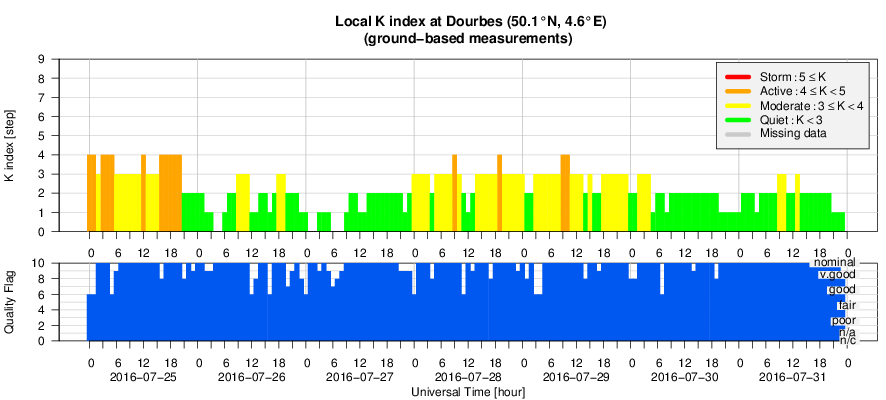- Table of Content
- 1.PROBA2 Observa...
- 2.Review of sola...
- 3.Geomagnetic Ob...
- 4.Review of iono...
- 5.Future Events
2. Review of solar and geomagnetic activity
3. Geomagnetic Observations at Dourbes (25 Jul 2016 - 31 Jul 2016)
4. Review of ionospheric activity (25 Jul 2016 - 31 Jul 2016)
5. Future Events
PROBA2 Observations (25 Jul 2016 - 31 Jul 2016)
Solar Activity
Solar flare activity fluctuated between very low and low during the week.
In order to view the activity of this week in more detail, we suggest to go to the following website from which all the daily (normal and difference) movies can be accessed: http://proba2.oma.be/ssa
This page also lists the recorded flaring events.
A weekly overview movie can be found here (SWAP week 331).
http://proba2.oma.be/swap/data/mpg/movies/weekly_movies/weekly_movie_2016_07_25.mp4
Details about some of this week's events, can be found further below.
If any of the linked movies are unavailable they can be found in the P2SC movie repository here
http://proba2.oma.be/swap/data/mpg/movies/
Tuesday Jul 26
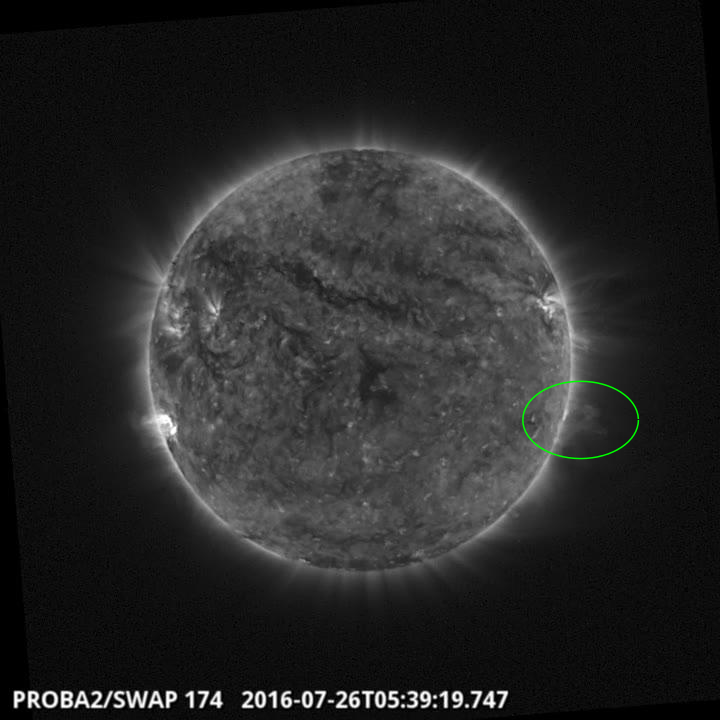
An eruption was observed by SWAP on the west limb of the Sun on 2016Jul26 at 05:39 UT
Find a movie of the event here (SWAP movie)
http://proba2.oma.be/swap/data/mpg/movies/20160726_swap_movie.mp4
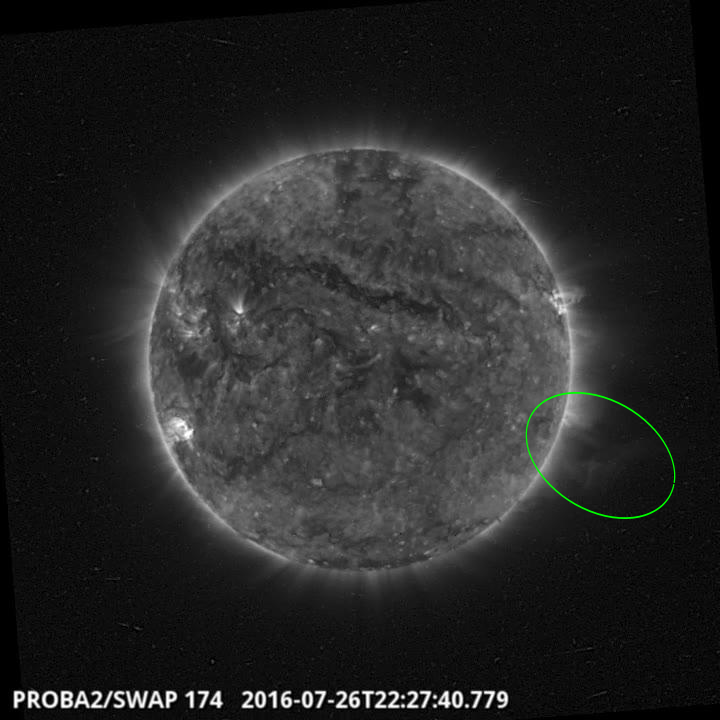
An eruption was observed by SWAP on the west limb of the Sun on 2016Jul26 at 22:27 UT
Find a movie of the events here (SWAP movie)
http://proba2.oma.be/swap/data/mpg/movies/20160726_swap_movie.mp4
Review of solar and geomagnetic activity
Solar Activity
The Sun was spotless until July 28 when NOAA AR 2570 (Catania 14) and Catania 13 (no NOAA number) emerged with a simple magnetic field configuration. Therefore, solar activity was very low throughout the week. The only flare occurred on July 25, C1.8 peak at 09:09 UT and was linked with NOAA 2567 that had already rotated over the west limb at that time. The background X-ray output was even below the B-level from July 27 onwards as can be seen in the graph below.
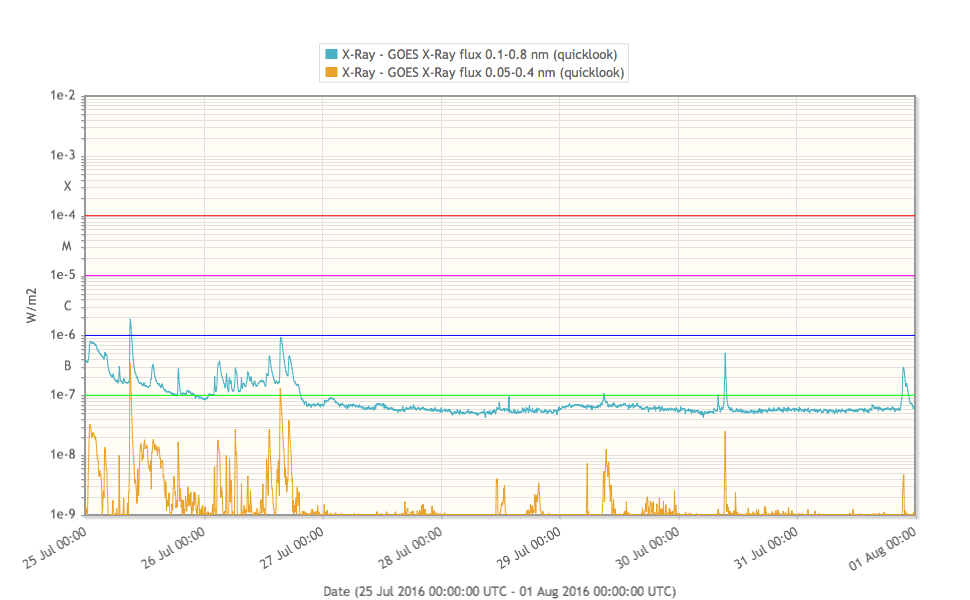
A filament erupted late on the UT day of July 28. The associated CME was first seen by LASCO C2 on July 28, 22:36 UT. The filament is visible in the rectangle on the AIA 304 picture below.
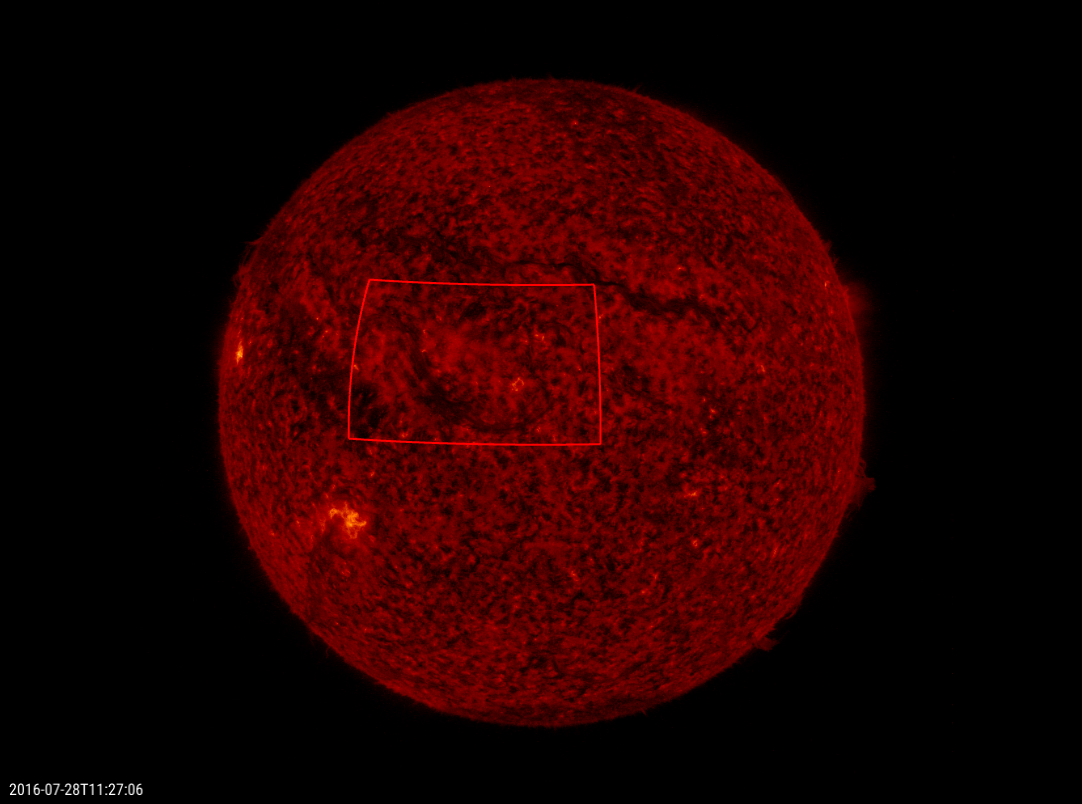
Geomagnetic Activity
The arrival of a high speed stream at Earth, induced active geomagnetic conditions (K = 4) on July 25 and on July 28 and 29. On July 30 and 31, the geomagnetic conditions were quiet to unsettled.
Review of ionospheric activity (25 Jul 2016 - 31 Jul 2016)
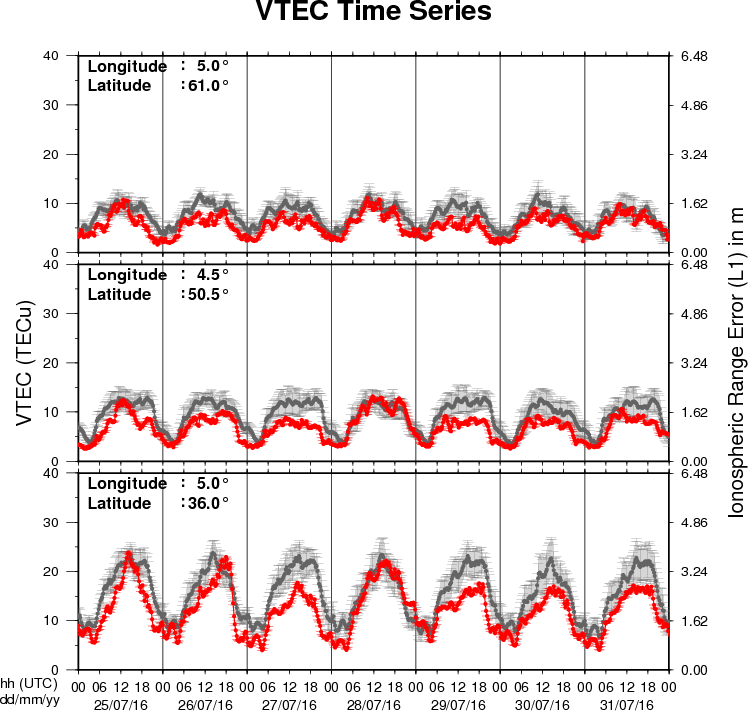
The figure shows the time evolution of the Vertical Total Electron Content (VTEC) (in red) during the last week at three locations:
a) in the northern part of Europe(N61°, 5°E)
b) above Brussels(N50.5°, 4.5°E)
c) in the southern part of Europe(N36°, 5°E)
This figure also shows (in grey) the normal ionospheric behaviour expected based on the median VTEC from the 15 previous days.
The VTEC is expressed in TECu (with TECu=10^16 electrons per square meter) and is directly related to the signal propagation delay due to the ionosphere (in figure: delay on GPS L1 frequency).
The Sun's radiation ionizes the Earth's upper atmosphere, the ionosphere, located from about 60km to 1000km above the Earth's surface.The ionization process in the ionosphere produces ions and free electrons. These electrons perturb the propagation of the GNSS (Global Navigation Satellite System) signals by inducing a so-called ionospheric delay.
See http://stce.be/newsletter/GNSS_final.pdf for some more explanations ; for detailed information, see http://gnss.be/ionosphere_tutorial.php
Future Events
For more details, see http://www.spaceweather.eu/en/event/future
Global Modelling of the Space Weather Chain in Helsinki, Finland
Start : 2016-10-24 - End : 2016-10-28
This event brings together solar, heliospheric, magnetospheric,
and ionospheric communities to discuss the current state and future
challenges in global modelling of the entire space weather chain.
Major developments in forecasting space weather, and understanding
the effects of solar eruptions requires increased communication and
collaboration of these often rather distinct communities. We
welcome submissions from these modelling communities and also
synergetic studies utilising both observations and numerical
models.
Website:
https://pnst.ias.u-psud.fr/sites/pnst/files/global_modelling_space_weather_oct2016.pdf
European Space Weather Week in Ostend, Belgium
Start : 2016-11-14 - End : 2016-11-18
The ESWW is the main annual event in the European Space Weather
calendar. It is the European forum for Space Weather as proven by
the high attendance to the past editions. The agenda will be
composed of plenary/parallel sessions, working meetings and
dedicated events for service end-users. The ESWW will again adopt
the central aim of bringing together the diverse groups in Europe
working on different aspects of Space Weather.
Website:
http://www.stce.be/esww13/
Solar Orbiter Workshop 7: Exploring the solar environs in Granada, Spain
Start : 2017-04-03 - End : 2017-04-06
This event will be hosted by the Instituto de Astrofisica de
Andalucia - CSIC. Please mind that on April 7th the 20th SWT
meeting will take place at the same venue.
Website: Unkown
